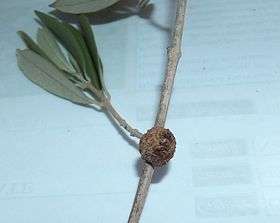Pseudomonas savastanoi
| Pseudomonas savastanoi | |
|---|---|
 | |
| Twig of olive-tree with a tumour caused by Pseudomonas savastanoi | |
| Scientific classification | |
| Kingdom: | Bacteria |
| Phylum: | Proteobacteria |
| Class: | Gamma Proteobacteria |
| Order: | Pseudomonadales |
| Family: | Pseudomonadaceae |
| Genus: | Pseudomonas |
| Species: | P. savastanoi |
| Binomial name | |
| Pseudomonas savastanoi (Janse 1982) Gardan, et al. 1992 | |
| Type strain | |
| ATCC 13522 | |
| Pathovars | |
|
P. s. pv. fraxini | |
| Synonyms | |
|
Pseudomonas syringae pv. savastanoi (Smith 1908) Young et al. 1978 | |
Pseudomonas savastanoi is a Gram-negative plant pathogenic bacterium that infects a variety of plants. It was once considered a pathovar of Pseudomonas syringae, but following DNA-relatedness studies, it was instated as a new species.[1] It is named after Savastano, a worker who proved between 1887 and 1898 that olive knot are caused by bacteria.[2] [3]
The pathovar of greatest economical significance is Pseudomonas savastanoi pv. savastanoi, which causes the disease olive knot. Symptoms include formation of galls on infected trees; tumour formation is induced by indoleacetic acid biosynthesis by the bacteria, in a similar manner to the well-studied crown gall pathogen, Agrobacterium tumefaciens.[4][5]
Pathovars
- Pseudomonas savastanoi pv. fraxini causes ash canker.[6]
- Pseudomonas savastanoi pv. nerii attacks oleander.[6]
- Pseudomonas savastanoi pv. savastanoi causes olive knot.[4]
- Pseudomonas savastanoi pv. phaseolicola attacks Phaseolus (bean) plants [7]
References
- ↑ Gardan; Shafik, H; Belouin, S; Broch, R; Grimont, F; Grimont, PA; et al. (Apr 1999). "DNA relatedness among the pathovars of Pseudomonas syringae and description of Pseudomonas tremae sp. nov. and Pseudomonas cannabina sp. nov. (ex Sutic and Dowson 1959)". Int J Syst Bacteriol. 49 (2): 469–78. doi:10.1099/00207713-49-2-469. PMID 10319466.
- ↑ George M. Garrity: Bergey's Manual of Systematic Bacteriology. 2. Auflage. Springer, New York, 2005, Volume 2: The Proteobacteria, Part B: The Gammaproteobacteria
- ↑ Joseph M. Ogawa,Harley English: Diseases of temperate zone tree fruit and nut crops
- 1 2 Hosni T, et al. 2011. Sharing of quorum-sensing signals and role of interspecies communities in a bacterial plant disease. ISME J. doi:10.1038/ismej.2011.65.
- ↑ Yamada, T; Lee, PD; Kosuge, T (1986). "Insertion sequence elements of Pseudomonas savastanoi: Nucleotide sequence and homology with Agrobacterium tumefaciens transfer DNA". Proceedings of the National Academy of Sciences of the United States of America. 83 (21): 8263–7. doi:10.1073/pnas.83.21.8263. PMC 386908
 . PMID 16593778.
. PMID 16593778. - 1 2 Smith, Dunez, Lelliot, Phillips and Archer (1988) European Handbook of Plant Disease. Blackwell Scientific Publications.
- ↑ B. P Borowicz, A Maćkowiak, H Pospieszny (2002) Improved identification of Pseudomonas savastanoi pv. phaseolicola at the molecular level. EPPO Bulletin 32 (3), 467–469.